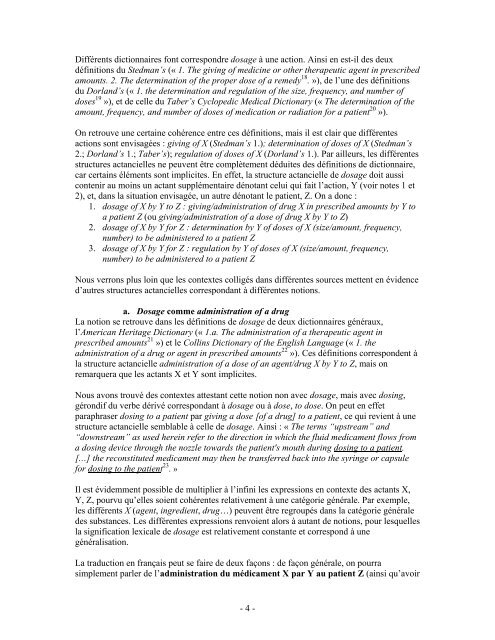Dose et dosage : sachons doser nos efforts! - Groupetraduction.ca
Dose et dosage : sachons doser nos efforts! - Groupetraduction.ca
Dose et dosage : sachons doser nos efforts! - Groupetraduction.ca
Create successful ePaper yourself
Turn your PDF publications into a flip-book with our unique Google optimized e-Paper software.
Différents dictionnaires font correspondre <strong>dosage</strong> à une action. Ainsi en est-il des deux<br />
définitions du Stedman’s (« 1. The giving of medicine or other therapeutic agent in prescribed<br />
amounts. 2. The d<strong>et</strong>ermination of the proper dose of a remedy 18 . »), de l’une des définitions<br />
du Dorland’s (« 1. the d<strong>et</strong>ermination and regulation of the size, frequency, and number of<br />
doses 19 »), <strong>et</strong> de celle du Taber’s Cyclopedic Medi<strong>ca</strong>l Dictionary (« The d<strong>et</strong>ermination of the<br />
amount, frequency, and number of doses of medi<strong>ca</strong>tion or radiation for a patient 20 »).<br />
On r<strong>et</strong>rouve une certaine cohérence entre ces définitions, mais il est clair que différentes<br />
actions sont envisagées : giving of X (Stedman’s 1.); d<strong>et</strong>ermination of doses of X (Stedman’s<br />
2.; Dorland’s 1.; Taber’s); regulation of doses of X (Dorland’s 1.). Par ailleurs, les différentes<br />
structures actancielles ne peuvent être complètement déduites des définitions de dictionnaire,<br />
<strong>ca</strong>r certains éléments sont implicites. En eff<strong>et</strong>, la structure actancielle de <strong>dosage</strong> doit aussi<br />
contenir au moins un actant supplémentaire dénotant celui qui fait l’action, Y (voir notes 1 <strong>et</strong><br />
2), <strong>et</strong>, dans la situation envisagée, un autre dénotant le patient, Z. On a donc :<br />
1. <strong>dosage</strong> of X by Y to Z : giving/administration of drug X in prescribed amounts by Y to<br />
a patient Z (ou giving/administration of a dose of drug X by Y to Z)<br />
2. <strong>dosage</strong> of X by Y for Z : d<strong>et</strong>ermination by Y of doses of X (size/amount, frequency,<br />
number) to be administered to a patient Z<br />
3. <strong>dosage</strong> of X by Y for Z : regulation by Y of doses of X (size/amount, frequency,<br />
number) to be administered to a patient Z<br />
Nous verrons plus loin que les contextes colligés dans différentes sources m<strong>et</strong>tent en évidence<br />
d’autres structures actancielles correspondant à différentes notions.<br />
a. Dosage comme administration of a drug<br />
La notion se r<strong>et</strong>rouve dans les définitions de <strong>dosage</strong> de deux dictionnaires généraux,<br />
l’Ameri<strong>ca</strong>n Heritage Dictionary (« 1.a. The administration of a therapeutic agent in<br />
prescribed amounts 21 ») <strong>et</strong> le Collins Dictionary of the English Language (« 1. the<br />
administration of a drug or agent in prescribed amounts 22 »). Ces définitions correspondent à<br />
la structure actancielle administration of a dose of an agent/drug X by Y to Z, mais on<br />
remarquera que les actants X <strong>et</strong> Y sont implicites.<br />
Nous avons trouvé des contextes attestant c<strong>et</strong>te notion non avec <strong>dosage</strong>, mais avec dosing,<br />
gérondif du verbe dérivé correspondant à <strong>dosage</strong> ou à dose, to dose. On peut en eff<strong>et</strong><br />
paraphraser dosing to a patient par giving a dose [of a drug] to a patient, ce qui revient à une<br />
structure actancielle semblable à celle de <strong>dosage</strong>. Ainsi : « The terms “upstream” and<br />
“downstream” as used herein refer to the direction in which the fluid medi<strong>ca</strong>ment flows from<br />
a dosing device through the nozzle towards the patient's mouth during dosing to a patient.<br />
[…] the reconstituted medi<strong>ca</strong>ment may then be transferred back into the syringe or <strong>ca</strong>psule<br />
for dosing to the patient 23 . »<br />
Il est évidemment possible de multiplier à l’infini les expressions en contexte des actants X,<br />
Y, Z, pourvu qu’elles soient cohérentes relativement à une <strong>ca</strong>tégorie générale. Par exemple,<br />
les différents X (agent, ingredient, drug…) peuvent être regroupés dans la <strong>ca</strong>tégorie générale<br />
des substances. Les différentes expressions renvoient alors à autant de notions, pour lesquelles<br />
la signifi<strong>ca</strong>tion lexi<strong>ca</strong>le de <strong>dosage</strong> est relativement constante <strong>et</strong> correspond à une<br />
généralisation.<br />
La traduction en français peut se faire de deux façons : de façon générale, on pourra<br />
simplement parler de l’administration du médi<strong>ca</strong>ment X par Y au patient Z (ainsi qu’avoir<br />
- 4 -


